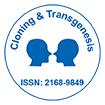
クローニングと遺伝子導入
オープンアクセス
ISSN: 2168-9849

ISSN: 2168-9849
Do VH and Taylor-Robinson AW
During the natural event of fertilization highly differentiated spermatozoa may revert to the totipotency of early embryonic stages. Such cells have the capacity to develop into a whole organism or to differentiate into any of its cells or tissues. Reversion is driven by the cytoplasm of the mature oocyte which is capable of reprogramming the donor nucleus. It is likely that the idea of using the laboratory technique of somatic cell nuclear transfer (SCNT) for creating an ovum with a donor nucleus stemmed from this observation. Many attempts have been made to determine the underlying mechanism of reprogramming and to improve nuclear transfer procedures in order to optimize the outcomes of SCNT. Although numerous reports have demonstrated the proof of principle of using SCNT technology to clone fertile offspring in several different mammalian species, success rates remain low. Most failures appear to result from incomplete reprogramming of the donor nucleus in an enucleated oocyte. The pressing need to improve the efficiency of SCNT may require a modified or entirely novel methodology to be established. This brief review discusses the mechanism responsible for reprogramming and considers several areas for research into SCNT in mammals that could yield beneficial outcomes.